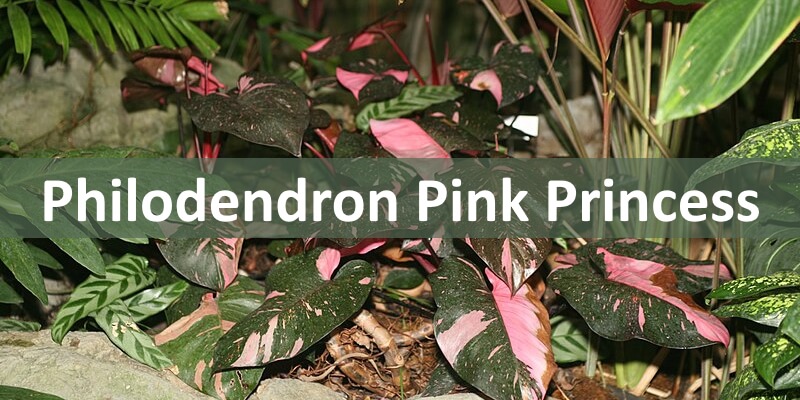
Philodendron Pink Princess Care Guide: How To Grow This Stunning Plant

The Philodendron’ Pink Princess’ is a stunning and sought-after tropical plant. The red-leaf philodendron adds a splash of pink foliage color to indoor gardens. This rare and beautiful pink plant has heart-shaped leaves with spectacular, vibrant pink and green variegation on red stems. However, caring for this plant may require special attention to ensure it thrives in your home.
Table of Contents
- Pink Princess Care: Quick Guide
- Philodendron Pink Princess Native Habitat and Origin
- Philodendron erubescens ‘Pink Princess’ Identification
- Philodendron Pink Princess vs. Pink Congo
- How to Care for Pink Princess Philodendron
- Tips for Repotting a Pink Princess Philodendron
- Propagating Pink Princess Philodendron
- Pink Princess Philodendron Care: Common Pests
- Pink Princess Philodendron Care: Common Plant Diseases
- Resolving Common Issues With Pink Princess Philodendron
- Buying a Pink Princess Philodendron House Plant
Despite its cost, the Philodendron Pink Princess has gained popularity in recent years. And it’s easy to see why. Also called the blushing philodendron, the plant has a striking appearance. However, it can be challenging to give it the right care. Proper watering, sunlight, and humidity are vital to keep its pink variegation vibrant and prevent it from reverting.
This Philodendron Pink Princess care guide explores essential tips and tricks for growing a healthy and thriving red-leaf plant. Whether you’re a beginner plant parent or a seasoned enthusiast, this guide will help you unlock the beauty of the Pink Princess in your indoor space.
Pink Princess Care Overview
Caring for the tropical Philodendron’ Pink Princess’ requires providing bright, indirect light and maintaining well-draining soil. Only water the pink plant when the top inch (2.5 cm) of soil is dry. Keep humidity levels above 60 percent and a temperature range of 65°F to 80°F (18°C to 26°C).
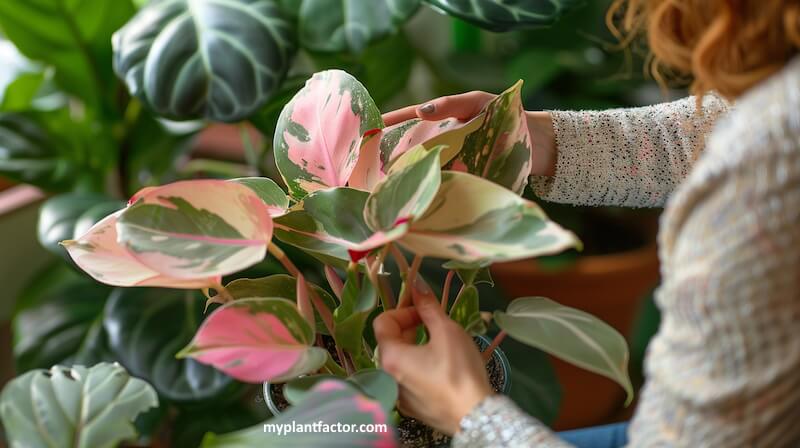
Philodendron Pink Princess Native Habitat and Origin
The Philodendron erubescens ‘Pink Princess’ is a type of aroid in the family Araceae native to the tropical rainforests of South America. The pink cultivar thrives in warm, humid environments with dappled sunlight. It’s an epiphyte plant, using its aerial roots to cling onto surfaces for support.
Thinking of adding a Philodendron Pink Princess to a pet household? See our full guide: Are Philodendrons Toxic to Cats and Dogs?
Philodendron erubescens ‘Pink Princess’ Identification
The identifying features of the Philodendron Pink Princess are its heart-shaped leaves featuring striking pink variegation. The pointed, cordate leaves grow on red stems and start dark green, transforming into an eye-catching bubblegum pink pattern. The Pink Princess flowers grow 6 inches (15 cm) tall and are deep red, fragrant spathes.
Identifying Pink Princess philodendron leaves
Philodendron Pink Princess leaves are heart-shaped, initially dark green, and undergo a captivating transformation as they mature. The distinctive feature is the vibrant pink variegation that emerges, creating a visually stunning and sought-after appearance. The leaves’ dynamic coloration and unique pattern make the Pink Princess a prized and enchanting houseplant.
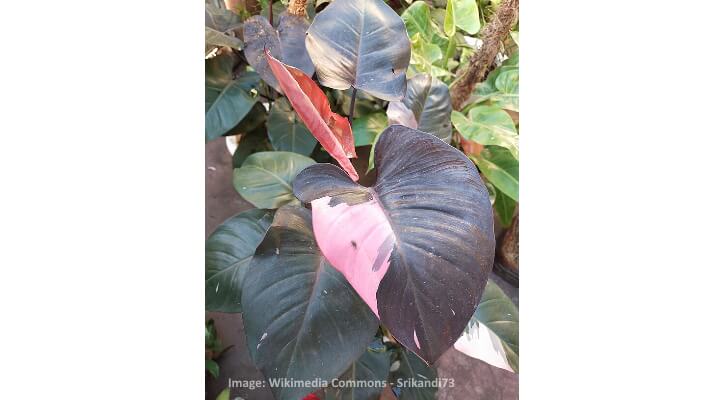
Identifying Pink princess flowers
Philodendron Pink Princess flowers are relatively rare. The pink plant can produce beautiful flowers under the right conditions. Pink princess flowers are relatively inconspicuous, greenish-white blooms. However, the conical flowers are surrounded by a showy, deep-red spathe—a modified leaf that surrounds the flower cluster. They grow 6 inches (15 cm) tall.
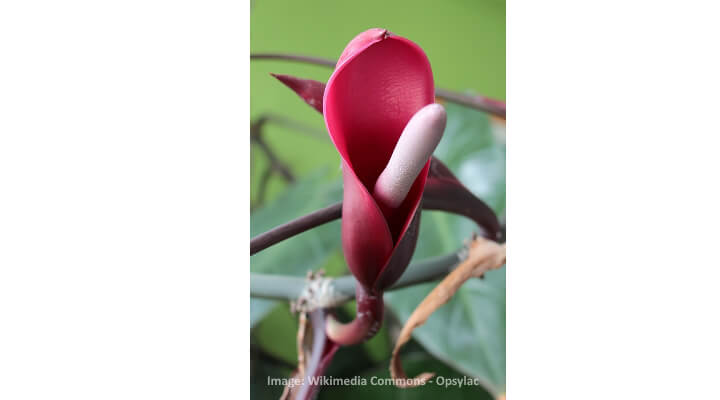
Philodendron pink princess seeds
It’s possible to buy Philodendron Pink Princess seeds. However, you can only grow standard red-leaf philodendron plants without the pink variegation. The Pink Princess Philodendron’s variegation is a natural mutation that occurs randomly. So, a reliably variegated plant can only be propagated through cuttings from a mother plant.
Discover 15 weird and wonderful facts about the Philodendron pink princess plant.
Philodendron Pink Princess vs. Pink Congo
The Pink Princess Philodendron can easily be mistaken for the Philodendron Pink Congo. Both have stunning pink, heart-shaped leaves. However, the pink princess features stable, natural variegation. In contrast, the Pink Congo’s variegation occurs due to chemicals injected into the leaves. This artificial variegation usually reverts to green.
How to Care for Pink Princess Philodendron
Philodendron Pink Princess care involves getting the right balance of sunlight, water, and humidity. Native to tropical regions, philodendron plants need bright, indirect light or filtered sunlight, ideal for indoor growth. Only water when the soil partially dries. Standard household humidity is usually OK for growing a healthy variegated philodendron.
Pink Princess: Light requirements
Put your pink princess philodendron where it gets several hours of bright, indirect sunlight daily. Good light conditions are the best way to ensure your pink princess has attractive variegation. When growing indoors, the pink-leaved philodendron can tolerate a few hours of direct sunlight, enhancing its variegation.
Use full-spectrum grow lights to increase light if your home lacks sufficient light. Without enough light, the pink princess leaves can revert to green and lose their stunning variegation. Also, insufficient direct sunlight can result in leggy growth. So, if you notice growth problems, ensure brighter light.
What is the best soil for blushing philodendron?
The pink princess philodendron thrives in airy, well-draining soil mix and high organic matter. The best medium to grow the pink plant is a mix of equal parts of standard potting soil, perlite, and orchid bark to create a well-draining potting mix.
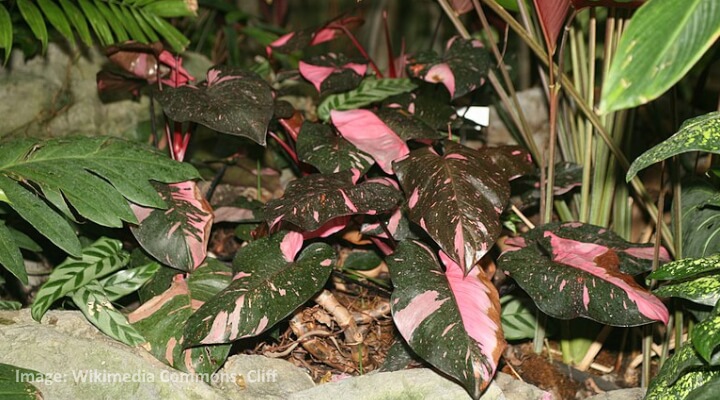
The soil must drain well to prevent waterlogged soil and root rot.
How to water philodendron pink princess
Water the pink princess whenever the top inch (2.5 cm) of soil is dry. When watering the pink princess, use enough water so it drains from the bottom of the pot. Typically, you should water it once a week during spring and summer and less frequently in fall and winter.
Remember—ambient temperature and humidity affect how often you water the pink princess.
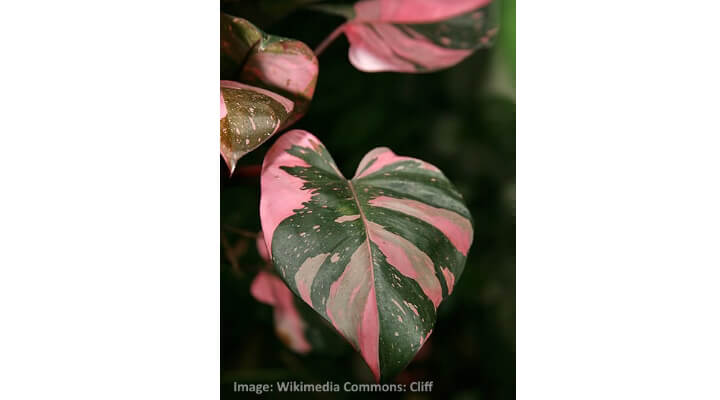
Avoiding soggy soil is a vital part of Pink Princess care. Overly damp conditions in the acidic soil mix can cause root rot. It’s easier to overwater your plant than to underwater it. Therefore, it’s best to wait a few days if you are unsure whether it needs water.
Pink Princess temperature range
Philodendron Pink Princess is a tropical plant that thrives in warm and humid environments. Ensure that average temperature is between 65°F to 80°F (18°C to 26°C). It can tolerate slightly cooler temperatures; however, temperatures below 60°F (15°C) can damage the plant’s health.
Humidity levels for the pink colorful plant
Average humidity levels to keep the stunning pink variegation should be 60 to 80 percent. Philodendron plants typically grow in humid conditions in their native environment. A lack of humidity can cause the pink princess leaves to turn brown and crisp.
Here are some ways to address a lack of humidity for your coveted plant with pink leaves:
- Mist the plant regularly
- Use a humidifier
- Place the potted tropical plant on a pebble tray
- Grow tropical plants together
Philodendron Pink Princess fertilization
Use a phosphorus-rich houseplant fertilizer to keep the Pink Princess healthy with vibrant foliage. A balanced fertilizer with an NPK rating of 15-7-15 is ideal. Apply the liquid fertilizer monthly during the spring and summer growing season. In early fall, stop fertilizing as the plant enters its dormant period.
It’s vital to flush the potting soil every so often to remove excess fertilizer that can build up around the plant’s root ball.
Tips for Repotting a Pink Princess Philodendron
Repot Philodendron Pink Princess plants every one to two years. The best to repot your pink beauty is spring. This is when the plant has vigorous growth and withstands the process better. It’s also best to wait until the plant needs watering before repotting, as you will water it in its new container.
Reasons for repotting a Pink Princess include refreshing the soil, giving roots more room to grow, and checking for signs of root rot.

Here are signs it’s time to report a Philodendron Pink Princess:
- Root bound: Visible roots circling the pot’s surface or emerging from drainage holes indicate the plant has outgrown its current container.
- Roots at the surface: If roots are visible at the soil surface, it indicates that the plant is becoming overcrowded, and repotting is necessary.
- Slow growth: Stunted or slowed growth despite proper care may signify the plant needs more space and nutrients.
- Waterlogged soil: Frequent waterlogging, even with proper watering, suggests inadequate drainage from compacted soil or being root-bound.
- Yellowing leaves: Consistent yellowing, especially in lower leaves, may signal nutrient depletion or compacted roots, necessitating repotting.
- Top-heavy appearance: If the plant appears top-heavy or leans excessively, it may be struggling to support its foliage, indicating the need for a more stable and larger container.
- Root rot symptoms: Foul odor, blackened, mushy roots, or yellowing leaves can be signs of root rot—repotting into fresh, well-draining soil is crucial.
- Exhausted soil nutrients: If the plant has been in the same soil for an extended period without supplemental feeding, repotting provides an opportunity to refresh nutrients.
A step-by-step guide to repot Pink Princess Philodendron
For repotting a Pink Princess, you’ll need a pot one to two sizes larger than its current one. Also, you’ll require fresh soil, a small trowel, pruning shears, and a watering can.
Here is how to repot a healthy variegated philodendron:
- Choose the right time: Repotting during the growing season—spring or early summer—is best. This is when the plant is actively growing. Avoid repotting during periods of stress or dormancy.
- Water the plant: Water your Pink Princess a day or two before repotting. The soil should be slightly moist but not waterlogged. Moist soil makes it easier to remove the plant from its current pot.
- Select a suitable pot: Choose a new pot that is 1 or 2 inches (2.5 to 5 cm) larger in diameter than the current one. Ensure the new container has sufficient drainage holes to prevent waterlogging.
- Prepare the workspace: Lay down newspaper or a drop cloth to make cleanup easier. Repotting can be messy, and this step helps minimize the mess.
- Gently remove the plant: Turn the current pot on its side and tap the bottom to loosen the plant. Gently slide the Pink Princess out, supporting the base of the plant with one hand while easing it out with the other.
- Inspect the roots: Carefully remove all the soil from the roots without damaging them. Examine the roots for signs of rot. Trim any dead or rotting roots using sterilized pruning shears or scissors.
- Add fresh potting mix: Place a layer of fresh potting mix in the bottom of the new pot. Ensure the soil mixture is suitable for aroids and offers good drainage.
- Position the plant: Center the Pink Princess in the new pot, ensuring it sits at the same depth as in the previous pot. Adjust the potting mix around the sides as needed.
- Fill the pot: Fill the remaining space around the plant with the potting mix, gently pressing it down to eliminate air pockets. Leave a 1 to 2-inch gap (2.5 to 5 cm) between the soil surface and the top of the pot.
- Water thoroughly: Water the plant thoroughly, allowing excess water to drain through the bottom holes. This helps settle the soil and ensures good root-to-soil contact.
After repotting the Philodendron Pink Princess, place it in a location with bright-indirect light. Over the next few weeks, observe the Pink Princess for signs of healthy growth. The repotting should result in improved vitality and continued development of its iconic, pink-variegated foliage.
Propagating Pink Princess Philodendron
Like most philodendrons, stem cuttings are the best Pink Princess propagation method. Propagating the red-leaf philodendron helps create a bushier plant. It also gives you new plants to gift to friends or sell online. Also, propagation can help resolve issues if the pink plant has started to revert.

Here is our Pink Princess Philodendron propagation guide:
- Choose the right stems: Select a stem from the parent plant with two or three leaves. There should also be two exposed nodes at its base.
- Cut the stem: With precision, utilize sharp and sterilized pruning shears or scissors to separate your cutting.
- Prepare the stem cutting: Delicately strip away the lower leaves from your cutting, retaining the top two leaves at the top for optimal propagation potential. Next, leave the cutting to air dry for 12 to 24 hours so the cut end can dry and form a callous.
- Root the cutting: Place the stem cutting in water and place it in bright, indirect light. Ensure the exposed nodes remain submerged in the water.
- New roots: It takes two to three weeks for new roots to appear. Once the creamy-white roots are at least 1 inch (2.5 cm) long, transfer them to a pot.
- Potting a propagated plant: Fill a pot with a well-draining potting. Make a hole in the center and put the cutting into the soil. Press down around the potting mix to give it stability. Water thoroughly.
Pink Princess Philodendron Care: Common Pests
Indoor houseplant pests can affect the Philodendron Pink Princess. These critters include tiny black bugs like aphids, spider mites, and mealybugs. Philodendron pests feed on the plant’s sap, leading to wilting, yellowing leaves, and potential damage. Regular inspection, gentle cleaning, and natural or chemical treatments can help manage and prevent pest infestations.
How to get rid of spider mites and aphids: Showering the plant with a forceful stream of water can help remove spider mites. Apply insecticidal soap or neem oil for severe infestations, ensuring thorough coverage to eliminate these tiny pests.
How to eliminate fungus gnats: Allow the soil to dry between waterings to get rid of fungus gnats for good. Use yellow sticky traps to catch adult gnats and incorporate a layer of sand or diatomaceous earth on the soil’s surface to deter larvae. Avoid overwatering and maintain good ventilation.
Pink Princess Philodendron Care: Common Plant Diseases
Overwatering causes the most common diseases with a Philodendron Pink Princess. Excessive moisture in the soil causes root rot and leaf spot diseases. Preventive measures include well-draining soil, controlled watering, and maintaining proper humidity levels to ensure the plant’s health.
Resolving Common Issues With Pink Princess Philodendron
When given proper care, pink princess philodendrons tend to be problem-free. Issues often arise due to improper watering, humidity, or light exposure.
Here are some solutions to common problems when growing a Pink Princess plant
Why is my pink princess getting leggy?
A Pink Princess Philodendron may become leggy due to insufficient light, prompting the plant to stretch in search of more sunlight. To address this, relocate the plant to a brighter spot with indirect light, encourage regular pruning, and rotate it periodically to ensure even exposure, promoting compact and bushy growth.
Help! My pink princess is losing its pink variegation
Philodendron Pink Princess may lose its pink variegation due to insufficient light exposure. To resolve the issue, put the plant in a location where it receives bright, indirect light. Do this in stages to aclimatize the pink plant to brighter light levels. Bright light maintains its distinctive pink coloring and promotes optimal growth.
Pink leaves turning brown
Pink Princess leaves may turn brown due to overwatering, causing root rot. Also, a lack of nutrients or too much direct sunlight can lead to foliage discoloration. Either reduce the watering frequency or place the pink plant in indirect sunlight.
Buying a Pink Princess Philodendron House Plant
Here is what you need to know before buying a Pink Princess Philodendron.
Why are pink princess philodendron plants so expensive?
Pink Princess Philodendron’s rarity, slow growth, and high demand contribute to its high price. The plant’s unique variegation, characterized by vibrant pink hues, adds to its desirability among collectors. Limited availability and intricate propagation methods further elevate its market value, making it a prized and costly botanical treasure.
How much does a pink princess plant cost?
In 2021, it wasn’t uncommon for a mature pink princess philodendron to sell for up to $2,000. Even a single-leaf cutting could fetch hundreds of dollars. Now, the cost of buying a pink princess is more affordable.
However, a well-established and highly variegated mature pink princess philodendron can cost $100 to $300. You can buy smaller plants for under $100. But the cheapest way to own a Pink Princess is to purchase rooted cuttings for around $10.
How to buy a healthy Philodendron ‘Pink Princess’
When buying a Philodendron ‘Pink Princess,’ choose a plant with vibrant, well-defined pink variegation. Check for lush, undamaged leaves and inspect the roots for signs of rot or pests. Purchase from reputable nurseries or sellers known for quality plants. Ensure the plant shows no signs of stress or disease, guaranteeing a healthy addition to your collection.
Where to purchase a pink princess philodendron
Pink princess philodendrons were previously only available on sites like Etsy and Facebook Marketplace and from plant collectors. However, these plants can be found in many houseplant shops and nurseries.
